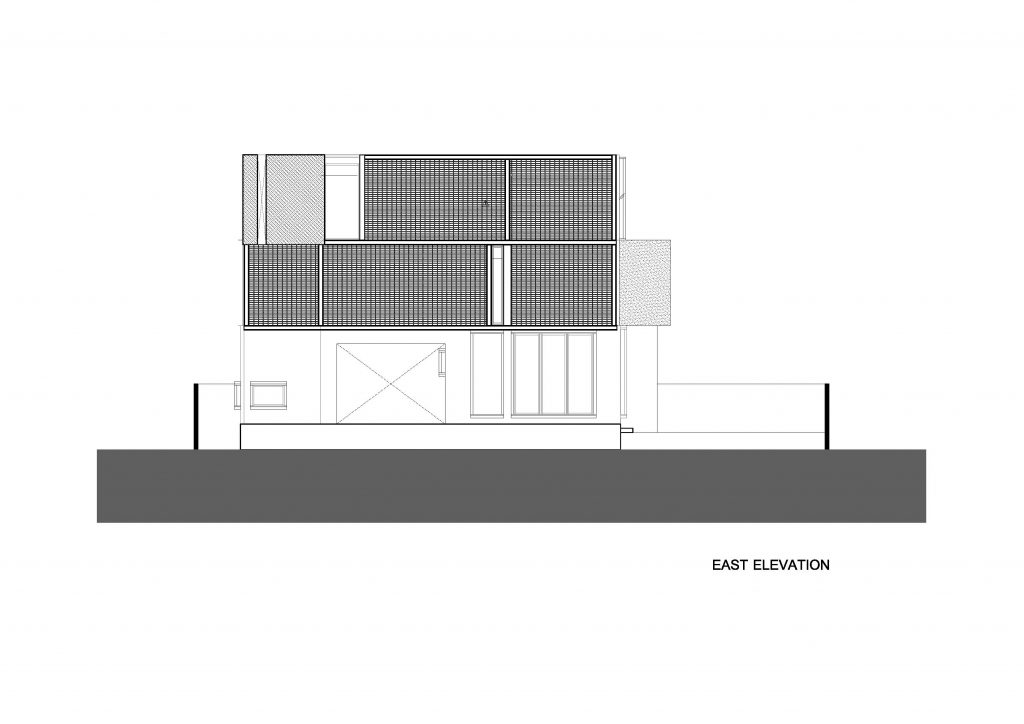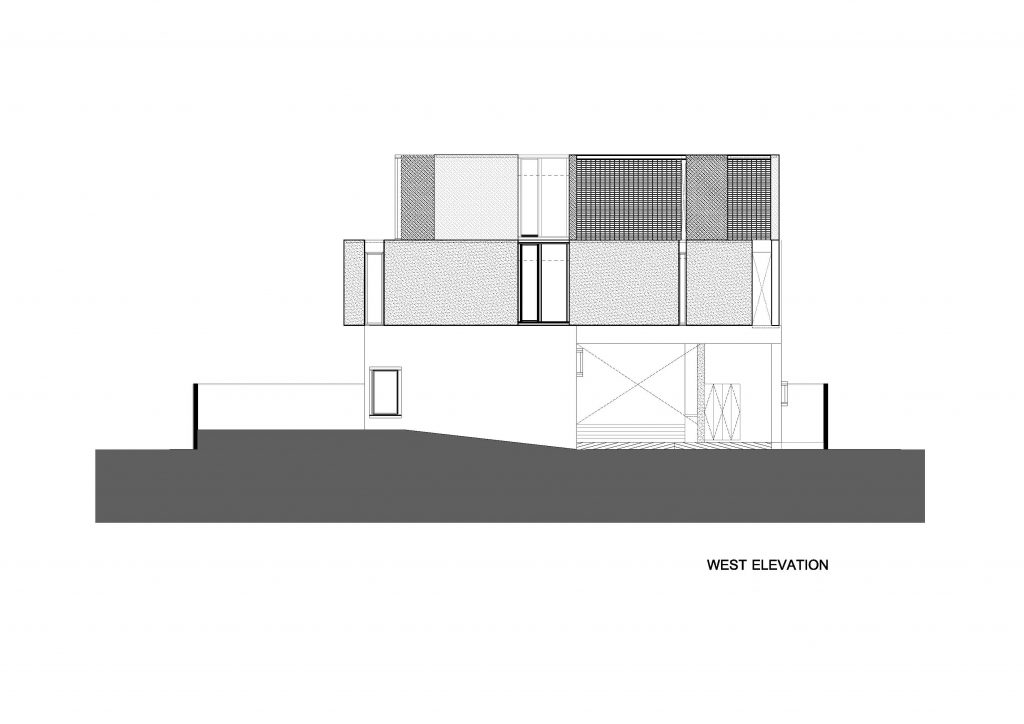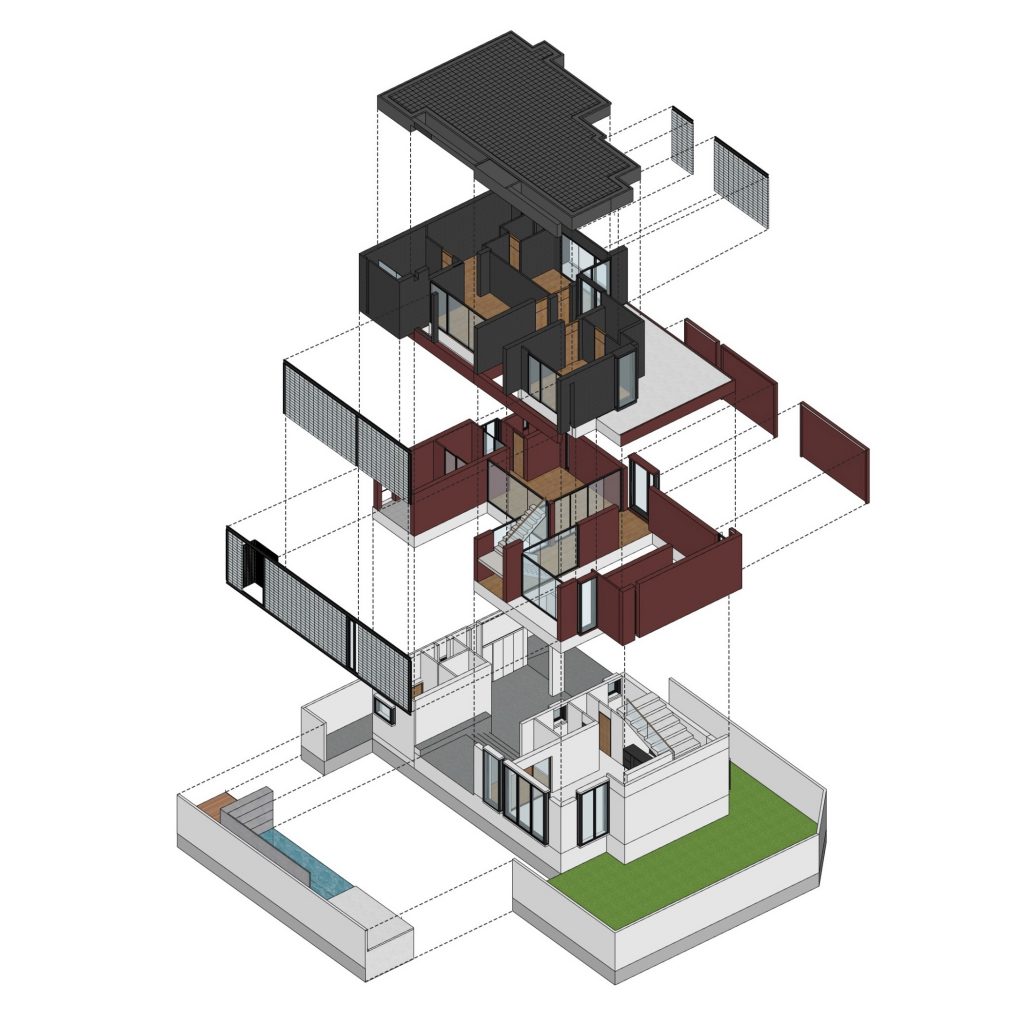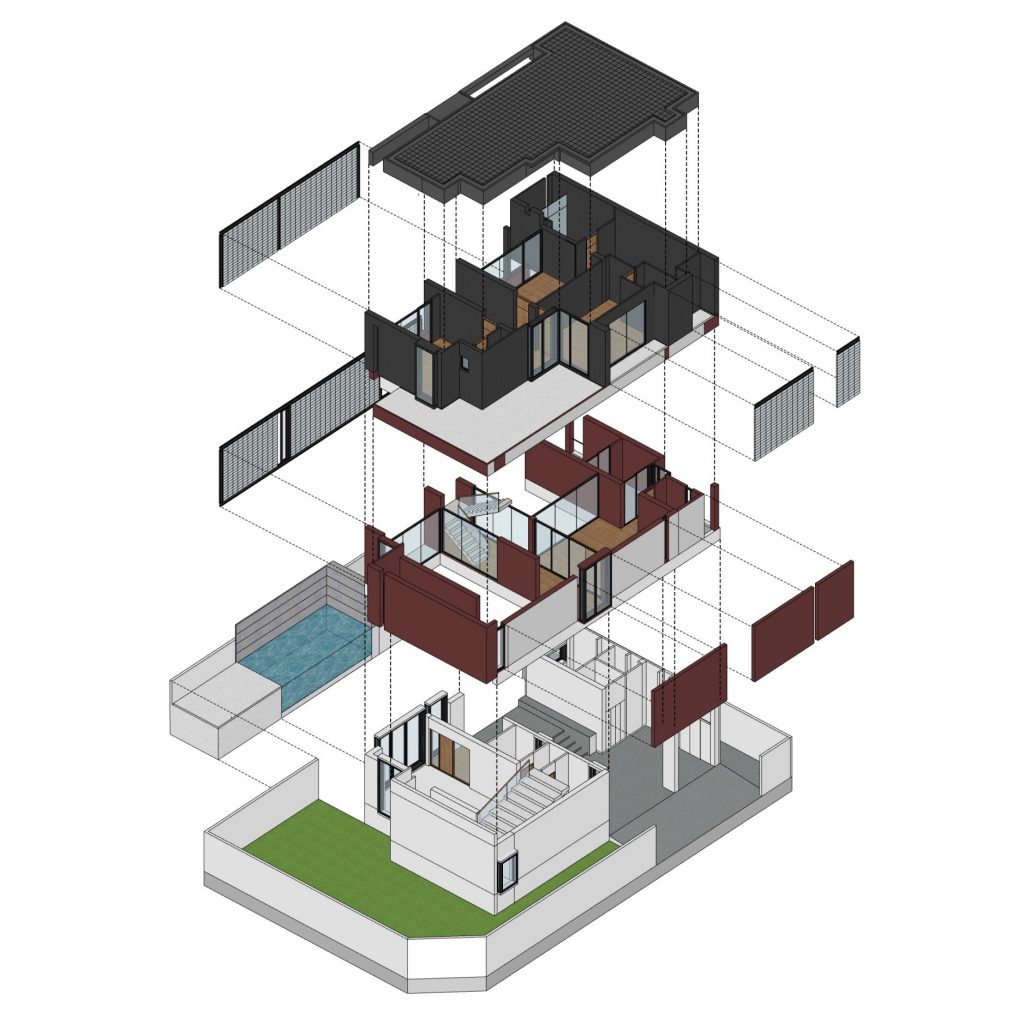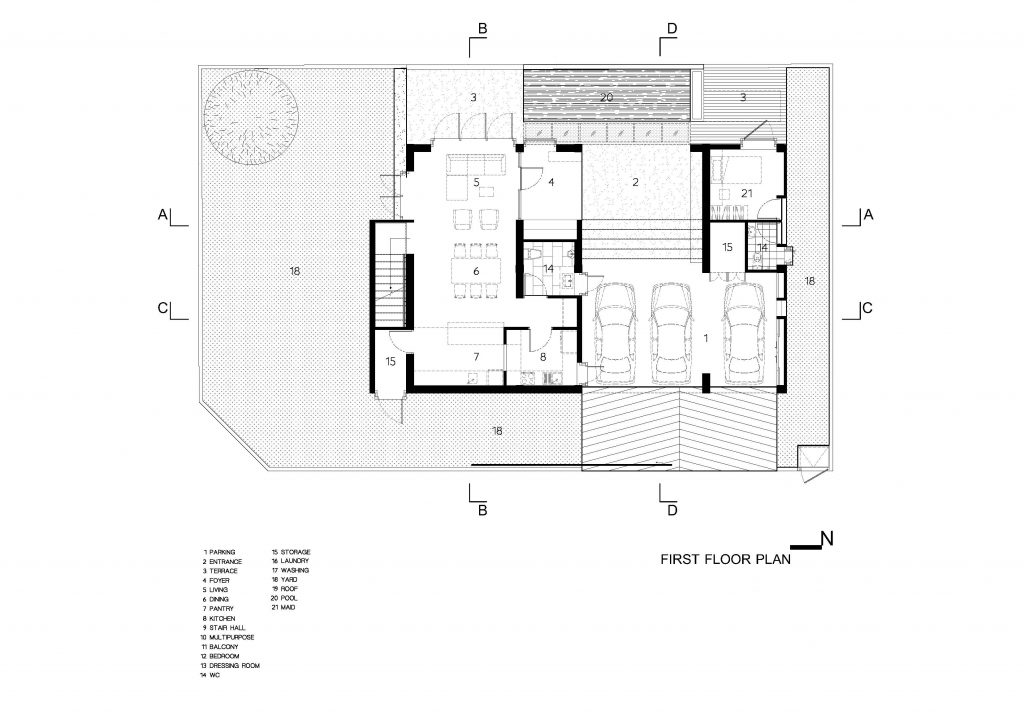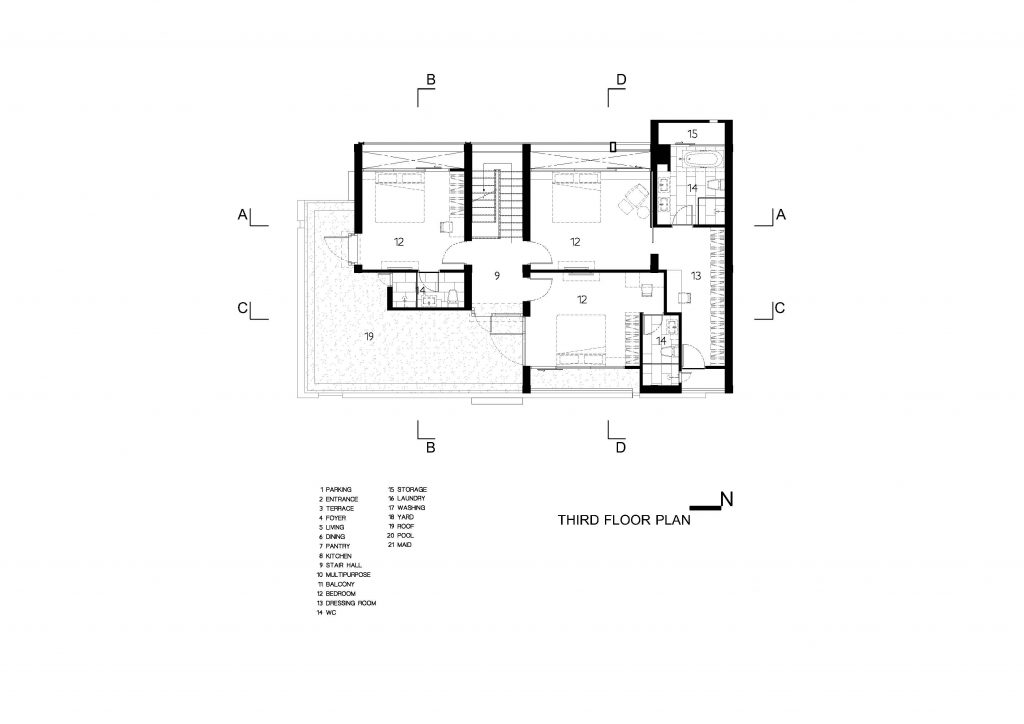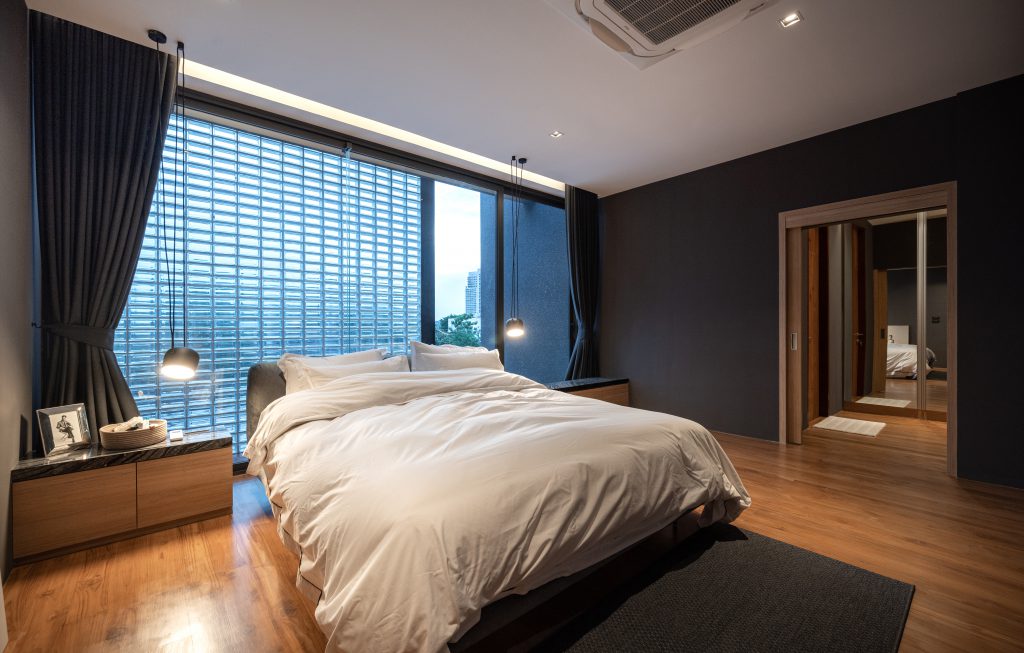Archimontage Design Fields Sophisticated has designed a house where each bedroom is a double-layered external wall to create a sense of safety and privacy while simultaneously filtering direct natural light and reducing heat.
Text: Phornnipa Wongprawmas
Photo: Rungrit Charoenwat, Achimontage Design Fileds Sophisticated except as noted
Download the online journal Issue 03 Seeing Through Click here
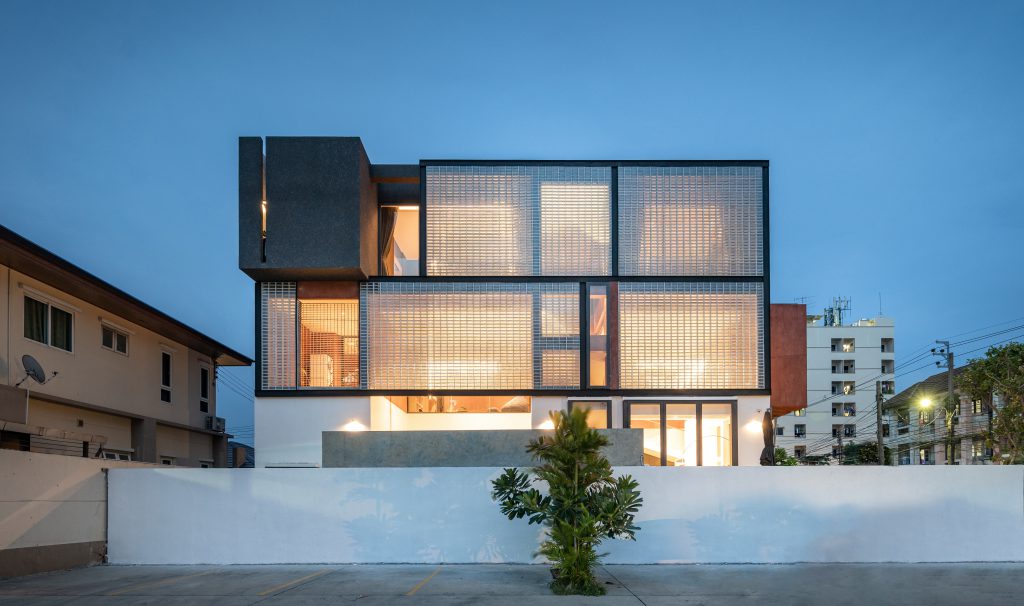
บริบทพื้นที่ที่แวดล้อมไปด้วยอาคารและสิ่งปลูกสร้างที่ตั้งอยู่แบบค่อนข้างประจันหน้ากันและมีระยะห่างระหว่างกันที่ค่อนข้างน้อย การสร้างสภาพแวดล้อมและบริบทของที่อยู่อาศัยขึ้นมาใหม่ที่เสมือนปิดล้อมแต่ยังสามารถสื่อสารกับธรรมชาติภายนอก จึงเป็นสาระสำคัญที่คุณเชิงชาย เรียวเรืองแสงกุล สถาปนิกและผู้ก่อตั้ง Archimontage Design Fields Sophisticated และทีมงาน ได้หยิบยกและให้ความสำคัญกับการออกแบบบ้านพักอาศัยส่วนตัว เพื่อตอบสนองความต้องการพื้นฐานของผู้อยู่อาศัยที่มีเจตนาในการใช้เป็นสถานที่สำหรับเริ่มต้นชีวิตคู่ บ้านพักอาศัย 3 ชั้น บนที่ดินขนาด 107 ตารางวารูปสี่เหลี่ยมผืนผ้าที่ติดถนนขนาดเล็กสองด้าน ทิศเหนือติดกับบ้านสองชั้น ทิศตะวันออกติดกับถนนย่อยและเนื่องจากมีความลึกจึงใช้เป็นทางเข้าของที่จอดรถ ทิศใต้เป็นถนนสัญจรหลัก และทิศตะวันตกจรดกับลานกว้าง ด้วยเงื่อนไขของลักษณะที่ดิน สถาปนิกจึงเลือกที่จะกำหนดทิศทางของตัวบ้านให้วางขนานไปตามความยาวของรูปที่ดิน โดยขยับตัวบ้านให้ชิดริมด้านในของผืนที่ดินมากที่สุด และสร้างพื้นที่สนามไว้ที่ส่วนด้านหน้าที่อยู่แนวทางเข้าจากถนนทั้งสองด้าน เพื่อลดแรงปะทะกับอาคารฝั่งตรงกันข้ามและเป็นการกรองความวุ่นวายจากสภาพแวดล้อมภายนอก
Photo Courtesy Achimontage Design Fileds Sophisticated except as noted Photo Courtesy Achimontage Design Fileds Sophisticated except as noted
สถาปนิกได้ออกแบบบ้านทั้ง 3 ชั้นให้มีพื้นที่เชื่อมโยงและต่อเนื่องกันทั้งพื้นที่ชั้นสอยและบรรยากาศภายใน โดยชั้นล่างถูกวางแผนให้ผู้ใช้สอยพื้นที่ต้องเดินเข้าสู่ระเบียงเพื่อผ่านบ่อปลาและโถงสูงสองชั้น (Double Volume) ที่มองผ่านเห็นโถงบันไดและห้องนั่งเล่นด้านบนก่อนที่จะเปิดประตูหลักเข้าสู่ตัวบ้าน เมื่อเข้าสู่ภายในตัวบ้านชั้นล่างมีพื้นที่ส่วนรับแขก ส่วนรับประทานอาหาร ส่วนเตรียมอาหาร และห้องครัวเป็นพื้นที่ใช้สอยหลัก โดยมีบันไดขึ้นชั้น 2 รูปตัว L โอบล้อมพื้นที่ทั้งหมดใว้ บันไดชุดนี้ได้ถูกออกแบบให้ช่วงมุมมองเปิดผ่านผนังกระจกใสมีขนาดพื้นที่กว้างพิเศษ เพื่อกึ่งบังคับให้การย่างก้าวแต่ละขั้นบันไดถูกยืดเวลาให้นานขึ้น นอกจากจะถูกใช้ประโยชน์เพื่อเป็นทางสัญจร ยังถูกทำหน้าที่เพื่อประวิงเวลาให้ผู้ใช้พื้นที่มีช่วงเวลารับรู้และสัมผัสกับบรรยากาศพื้นที่ที่เป็นโถงสูงสองชั้น (Double Volume) และกระจายทัศนะเพื่อเชื่อมไปยังส่วนอื่นๆ ของบ้าน
โถงบันไดตัว L นี้ได้ส่งต่อช่วงบรรยากาศพื้นที่สู่ชั้น 2 เพื่อเชื้อเชิญเข้าสู่ห้องนั่งเล่นซึ่งเป็นส่วนที่สมาชิกภายในบ้านใช้พื้นที่เป็นเวลานานต่อวันและหลายช่วงเวลา บรรยากาศพื้นที่บริเวณนี้ถูกปรับเปลี่ยนไปตามแสงธรรมชาติจากภายนอกของแต่ละช่วงวันที่ฉายผ่านบนผนังบล็อกแก้ว (Glass Block) ทำให้เกิดมิติช่วงเวลาและบรรยากาศเรื่องราวภายในบ้านที่สร้างขึ้นมาใหม่ผ่านองค์ประกอบนี้ และถูกใช้ทำหน้าที่เป็นม่านผนังแก้วเพื่อพรางพื้นที่ส่วนซักรีดและลานซักล้างที่ซ่อนไว้ด้านหลังสุดของบ้านจากมุมมองภายนอก การเดินทางผ่านพื้นที่ส่วนกลางของบ้านไปจรดกับพื้นที่ส่วนตัวด้วยอีกโถงบันไดที่เคยมองเห็นจากชั้นล่าง นำขึ้นไปสู่พื้นที่ส่วนชั้น 3 ที่ถูกออกแบบอย่างเป็นสัดส่วนสำหรับใช้เป็นพื้นที่ห้องนอนจำนวน 3 ห้อง ทุกห้องมีผนังด้านที่ติดกับสภาพแวดล้อมภายนอกที่ถูกกรองไว้ด้วยผนัง 2 ชั้น คือ ผนังบล็อกแก้วที่ต่อเนื่องเป็นผืนเดียวจากผนังชั้น 2 และผนังกระจกที่อยู่ชั้นในเพื่อช่วยสร้างความรู้สึกปลอดภัยและความเป็นส่วนตัว รวมถึงเป็นการปรับแสงสว่างจากภายนอกให้นุ่มนวลและไม่ปะทะกับผู้อยู่อาศัยโดยตรง ตามที่สถาปนิกได้นิยามไว้ว่า “นี่คือการต่อรองและสนทนากับดวงอาทิตย์”
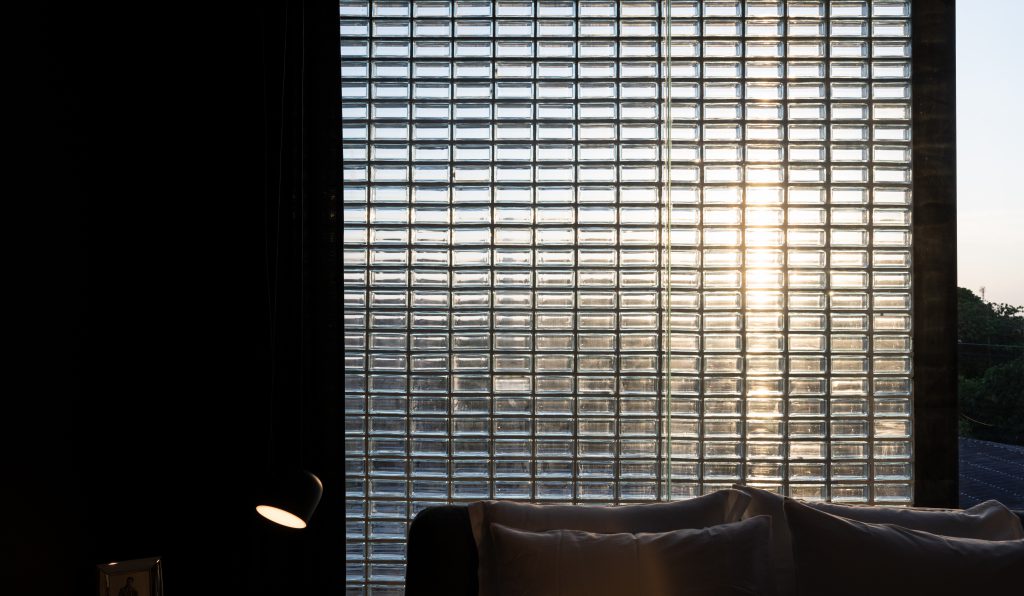

ผนังบล็อกแก้ว (Glass Block) มุมมองของใครหลายคนอาจมองว่าเป็นวัสดุประกอบที่ค่อนข้างสามัญ แต่สถาปนิกได้นำไปใช้เพื่อสร้างภาษาและลักษณะเฉพาะตัวเพื่อสร้างความโดดเด่นให้กับสถาปัตยกรรม เป็นการแปรเปลี่ยนหน้าที่ของผนังที่เคยถูกใช้ประโยชน์เชิงกายภาพในการกั้นอาณาเขตหรือพื้นที่ให้แยกออกจากกัน กลายเป็นการต้อนรับสภาพแวดล้อมภายนอกเข้ามาเป็นส่วนหนึ่งกับบรรยากาศภายใน และเป็นองค์ประกอบที่ช่วยปรุงแต่งแสงธรรมชาติที่สาดส่องเข้ามาสู่ภายในบ้าน ทำให้เกิดความสุนทรีย์แก่ผู้อยู่อาศัยตามแต่ละช่วงเวลาที่แปรเปลี่ยนไป อีกนัยคือการใช้ประโยชน์จากระนาบของผนังบล็อกแก้วผืนใหญ่เพื่อพรางสายตาและสร้างความเป็นส่วนตัว ถึงแม้ว่ารูปทรงของสถาปัตยกรรมจะดูเป็นทรงกล่องสี่เหลี่ยมที่ดูหนักแน่น ความแยบยลในการเลือกใช้วัสดุที่มีการหักเหของแสงตกกระทบและสะท้อนประกายบนผิวผนังบล็อกแก้ว กลับช่วยลดทอนรูปทรงของสถาปัตยกรรมให้ดูเบาลงได้อย่างน่าสนใจ และเมื่อนำไปใช้ร่วมกับวัสดุองค์ประกอบอื่นเพื่อสร้างผิวอาคารร่วมกัน ทำให้สถาปัตยกรรมเกิดบุคลิกบรรยากาศเป็น 4 แบบ คือ ความขาวกระจ่าง ดินโคลน เกล็ดหิน และความโปร่งทะลุ เป็นการสร้างการรับรู้และการสร้างบริบทใหม่ให้กับผู้อยู่อาศัย
Photo Courtesy Achimontage Design Fileds Sophisticated except as noted Photo Courtesy Achimontage Design Fileds Sophisticated except as noted
การสื่อสารแนวความคิดจากสถาปนิกผ่านรูปแบบสถาปัตยกรรมที่วางแผนเพื่อออกแบบให้ผิวสัมผัสของบ้านทั้ง 3 ชั้นมีความแตกต่างกันทั้งที่ไม่มีความจำเป็น ผนังภายนอกอาคารที่ถูกฉาบทับไว้ด้วยเกล็ดหินสีดำละเอียดกับผนังโคลนน้ำตาลส้มที่ปะติดปะต่อเป็นเนื้อเดียวกัน ถูกเล่นล้อด้วยช่องแสงทรงแถบยาวหลายช่องที่กระจายรอบตัวอาคาร ผนวกกับผนังบล็อกแก้วผืนใหญ่ที่ร้อยเรียงและยึดโยงแต่ละองค์ประกอบเข้าไว้ด้วยกัน เป็นเจตนาที่สถาปนิกต้องการส่งสารไปสู่ผู้อยู่อาศัย “ต่างแนวคิดแต่ร่วมอยู่ด้วยกันได้” สถาปนิกได้วางแผนและออกแบบเพื่อสร้างสภาพแวดล้อมและสร้างบริบทของที่อยู่อาศัยขึ้นมาใหม่ เพื่อสอดรับกับความต้องการของผู้อยู่อาศัยที่ครอบคลุมในทุกมิติ อันได้แก่การอนุญาตให้โลกภายนอกยังคงสนทนากับบรรยากาศภายใน ตลอดจนการใช้อุบายสร้างความสงบให้กับครอบครัวใหม่ที่ต้องการความเป็นส่วนตัว แต่ยังคงเหลือมิติที่มองไม่เห็นบางอย่างไว้เพื่อให้ผู้อยู่อาศัยได้เกิดจินตนาการต่อเองได้บ้าง
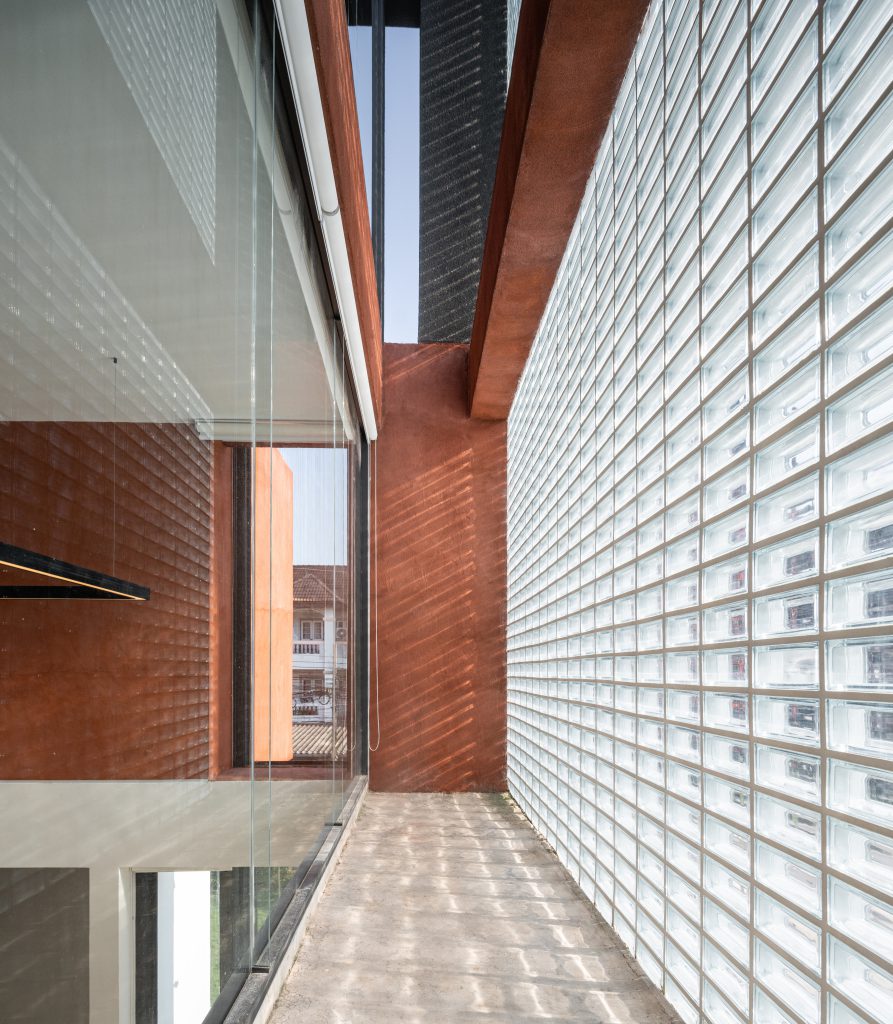
The composition of the space and its context is surrounded by clustered and tightly packed buildings which led Cherngchai Riawruangsangkul, the founder of Archimontage Design Fields Sophisticated and his design team to establish the rationale of designing a private residence. The space would be designed for a new married couple with the intent to meet the needs of the residents and create a context that is enclosed but also addresses and connects with its external natural environment within the constraints of its location.
The three-storey residence is located on a 428 square meter rectangular-shaped lot, adjacent to a small access to a road on both sides. The northern side of the lot faces a 2-storey house, while the eastern side faces a local roadway serving as an entry point to the residence via a small parking area. The southern side serves as the main road and the western side has a courtyard. Due to the configuration of the site and its location, the residence was designed to run parallel to its long side, positioning the building as close to the inner portions of the site as practically possible. Open spaces were also designated on two fronts located near the entrance from the road to help minimize and filter any physical adjacency from the adjoining houses.

The first floor comprises of a reception area, dining section, and kitchen as the main utility spaces. This area is surrounded by an ‘L’ shaped staircase boarded by a large glass wall that creates an extended perspective for occupants that somewhat inadvertently must take their time to view the surrounding internal environment. The staircase also serves as an opportunity for the occupants to take in and appreciate the adjoining double volume of space down towards the first floor that creates a singular uninterrupted aesthetic and atmosphere.
The second floor is reached at the end of the staircase leading into the main living room which is a space readily and frequently occupied. The room itself is exposed to a significant degree of natural light that changes both the atmosphere and character of the room dependent on the time of day and level of natural light versus shadow available. The light itself passes through a glass block wall that in a way, creates a new dimension in time creating and recreating differing environments, stories and memories. It also serves as a curtain to obscure the laundry room hidden in the furthest back part of the house.
Photo Courtesy Achimontage Design Fileds Sophisticated except as noted Photo Courtesy Achimontage Design Fileds Sophisticated except as noted Photo Courtesy Achimontage Design Fileds Sophisticated except as noted
Travelling through the common spaces finally connects to a private stair that leads to the third floor that was seen from the ground floor. The floor space is designed and designated proportionately into three separate bedrooms. Each bedroom is treated with a double-layered external wall that allows a visual connection to the surrounding environment. The outer layer of the wall is made of glass blocks that continue up from the second floor, while the inner wall is sheet glass. Both layers of the wall by way of their combination and properties, serve to create a sense of safety and privacy for the occupants while simultaneously significantly filtering direct natural light and reducing heat. The architect defines this design concept as “A negotiation and conversation with the sun”.
Glass blocks are considered to be a rather generic component in architectural design from the point of view of many people; however, architects use the material and its inherent properties to sometimes create a signature and bring a unique character for their work. No longer is it seen as a utilitarian material used solely as partitioning borders for spaces. Its utilization in the context of this residence seemingly blends internal with external environments through manipulating light, shade, and form to various degrees depending on weather conditions at the time creating a comfortable though aesthetically changing atmosphere.
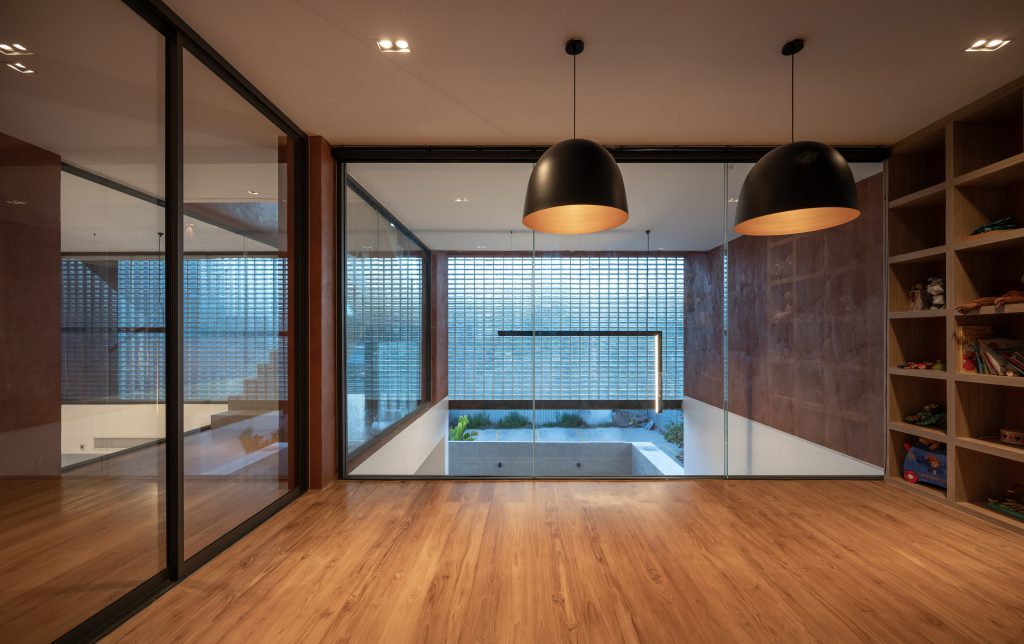
Another unique property of glass block is its ability to obscure and fragment visibility into the residence from the outside providing a sense of privacy to occupants. Although the shape, and structure of the glass block make it seem visually ‘heavy’, the refraction of light obtained through its use interestingly tends to lighten its perceived mass. Using this material in combination with other materials for the residential facade provides for multiple emerging characteristics including luminosity, obscurity, texture, and transparency, all of which create the sense of perception and context.
Photo: Rungrit Charoenwat Photo: Rungrit Charoenwat
f the façade seems unnecessarily different as does the orange-brownish façade tones with its fine black pebble coating and long slits that ubiquitously slither around the structure. These attributes, combined with the large expanses of glass block wall elements seem to blend seamlessly together, with an obvious message by the architect: “Unity despite differences”, it is through the process of design and its interpretation that an architect communicates his ideas.
The planning and overall design of this residence by the architect is done so with the intent of creating a new context in its surroundings to meet the needs of the occupants, provide privacy and a positive and harmonious synergy between the internal and external environment. There are however still some invisible dimensions left for the residents to create and explore with their own imaginations.


